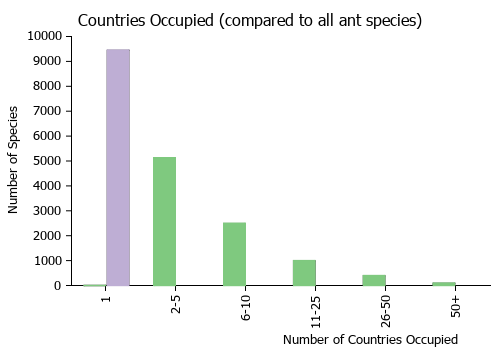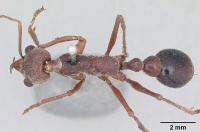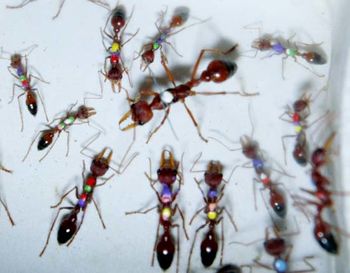Myrmecia gulosa
| Myrmecia gulosa | |
|---|---|

| |
| Scientific classification | |
| Kingdom: | Animalia |
| Phylum: | Arthropoda |
| Class: | Insecta |
| Order: | Hymenoptera |
| Family: | Formicidae |
| Subfamily: | Myrmeciinae |
| Tribe: | Myrmeciini |
| Genus: | Myrmecia |
| Species group: | gulosa |
| Species: | M. gulosa |
| Binomial name | |
| Myrmecia gulosa (Fabricius, 1775) | |
| Synonyms | |
| |
Identification
Keys including this Species
Distribution
Latitudinal Distribution Pattern
Latitudinal Range: -24.91444397° to -37.13333333°.
| North Temperate |
North Subtropical |
Tropical | South Subtropical |
South Temperate |
- Source: AntMaps
Distribution based on Regional Taxon Lists
Australasian Region: Australia (type locality).
Distribution based on AntMaps
Distribution based on AntWeb specimens
Check data from AntWeb
Countries Occupied
| Number of countries occupied by this species based on AntWiki Regional Taxon Lists. In general, fewer countries occupied indicates a narrower range, while more countries indicates a more widespread species. |

|
Estimated Abundance
| Relative abundance based on number of AntMaps records per species (this species within the purple bar). Fewer records (to the left) indicates a less abundant/encountered species while more records (to the right) indicates more abundant/encountered species. |

|
Biology
Colonies are monogynous and consist of 992 ± 551 workers, mean ± SD (Dietemann et al. 2002).
There is no trophallaxis but workers lay trophic eggs (non viable yolk sacs), which constitute the main channel of food exchange in the colony. Queens regularly walk through the nest chambers but they are not aggressive toward workers (Dietemann et al. 2005a). Regulation of worker reproduction is based on Cuticular Hydrocarbons (Dietemann et al. 2003) together with worker policing (Dietemann et al. 2005b).
Association with Other Organisms
 Explore: Show all Associate data or Search these data. See also a list of all data tables or learn how data is managed.
Explore: Show all Associate data or Search these data. See also a list of all data tables or learn how data is managed.
This species is a host for the eucharitid wasp Austeucharis fasciiventris (a parasite) (Universal Chalcidoidea Database) (primary host).
Life History Traits
- Mean colony size: 900 (Haskins & Haskins, 1950; Robertson, 1971; Beckers et al., 1989)
- Foraging behaviour: solitary forager (Haskins & Haskins, 1950; Robertson, 1971; Beckers et al., 1989)
Castes
Worker size varies over a wide range (14 – 23 mm), exhibiting a bimodal distribution. M. gulosa queens are only slightly bigger than large workers, but have many more ovarioles (44 compared to 8–14 in workers; Dietemann et al. 2002).
Images from AntWeb
   
| |
| Queen (alate/dealate). Specimen code casent0103309. Photographer April Nobile, uploaded by California Academy of Sciences. | Owned by CAS, San Francisco, CA, USA. |
Phylogeny
| Myrmecia |
| ||||||||||||||||||||||||||||||||||||||||||||||||||||||||||||||||||||||||||||||||||||||||||||||||||||||||||||||||||||||||||||||||||||||||||||||||||||||||||||||||||||||||||||||||||||||||||||||||||||||||||||||||||||||||||||||||||||||||||||||||||||||||||||||||||||||||||||||||||||||||||||||||||||||||||||||||||||||||||||||||||||||||||||||||||||||||||||||||||
Based on Mera-Rodríguez et al. (2023).
Nomenclature
The following information is derived from Barry Bolton's Online Catalogue of the Ants of the World.
- gulosa. Formica gulosa Fabricius, 1775: 395 (w.) AUSTRALIA (no state data).
- Type-material: holotype worker.
- Type-locality: Australia (“New Holland”): (no further data).
- Type-depository: BMNH.
- Smith, 1858b: 143 (m.); Mayr, 1876: 95 (q.); Wheeler, G.C. & Wheeler, J. 1971d: 246 (l.); Imai, Crozier & Taylor, 1977: 345 (k.).
- Combination in Eciton: Latreille, 1804 179; Latreille, 1817c: 75;
- combination in Myrmica: Latreille, 1809: 130; Guérin-Méneville, 1838: 207;
- combination in Myrmecia: Fabricius, 1804: 424; Smith, F. 1858b: 143.
- Status as species: Fabricius, 1775: 395; Fabricius, 1782: 494; Fabricius, 1787: 310; Gmelin, 1790: 2803; Christ, 1791: 511; Olivier, 1792: 501; Fabricius, 1793: 363; Latreille, 1802c: 215; Fabricius, 1804: 424; Latreille, 1809: 131; Latreille, 1817c: 75; Lamarck, 1817: 97; Guérin-Méneville, 1838: 207; Smith, F. 1858b: 143; Roger, 1861a: 33; Mayr, 1862: 723 (in key); Roger, 1863b: 22; Mayr, 1863: 430; Mayr, 1865: 84; Lowne, 1865b: 335; Mayr, 1876: 95 (redescription); Emery, 1887b: 443; Dalla Torre, 1893: 20; Emery, 1911d: 19; Clark, 1925b: 141; Wheeler, W.M. 1933i: 29; Clark, 1951: 49 (redescription); Taylor & Brown, 1985: 11; Taylor, 1987a: 43; Ogata, 1991a: 358; Ogata & Taylor, 1991: 1637 (in key); Bolton, 1995b: 271.
- Senior synonym of obscurior: Clark, 1951: 49; Taylor & Brown, 1985: 11; Taylor, 1987a: 43; Ogata & Taylor, 1991: 1629; Bolton, 1995b: 272.
- Distribution: Australia.
- obscurior. Myrmecia gulosa var. obscurior Forel, 1922: 87 (w.) AUSTRALIA (no state data,).
- Type-material: syntype workers (number not stated).
- Type-locality: Australia: (no further data, “sans autres indications de localité”).
- Type-depository: MHNG.
- Junior synonym of gulosa: Clark, 1951: 49; Taylor & Brown, 1985: 11; Taylor, 1987a: 43; Ogata & Taylor, 1991: 1629; Bolton, 1995b: 272.
Type Material
- Myrmecia gulosa: Syntype, worker(s), Australia, Australia, Musee d'Histoire Naturelle Genève.
- Formica gulosa: Holotype, worker, Australia (as New Holland), Australia, The Natural History Museum.
Description
Karyotype
- See additional details at the Ant Chromosome Database.
 Explore: Show all Karyotype data or Search these data. See also a list of all data tables or learn how data is managed.
Explore: Show all Karyotype data or Search these data. See also a list of all data tables or learn how data is managed.
- 2n = 38 (Australia) (Imai et al., 1977; Meyne et al., 1995; Hirai et al., 1996).
References
- Adams, R.M.M., Wells, R.L., Yanoviak, S.P., Frost, C.J., Fox, E.G.P. 2020. Interspecific Eavesdropping on Ant Chemical Communication. Frontiers in Ecology and Evolution 8. (doi:10.3389/fevo.2020.00024).
- Als, V., Narendra, A., Arthofer, W., Krapf, P., Steiner, F.M., Schlick-Steiner, B.C. 2021. Colony structure, population structure, and sharing of foraging trees in the ant Myrmecia nigriceps (Hymenoptera: Formicidae). Insectes Sociaux 68, 327–335 (doi:10.1007/s00040-021-00831-7).
- Barassé, V., Touchard, A., Téné, N., Tindo, M., Kenne, M., Klopp, C., Dejean, A., Bonnafé, E., Treilhou, M. 2019. The peptide venom composition of the fierce stinging ant Tetraponera aethiops (Formicidae: Pseudomyrmecinae). Toxins 11, 732 (doi:10.3390/toxins11120732).
- Beckers R., Goss, S., Deneubourg, J.L., Pasteels, J.M. 1989. Colony size, communication and ant foraging Strategy. Psyche 96: 239-256 (doi:10.1155/1989/94279).
- Billen, J., Khalife, A., Ito, F., Anh, N.D., Esteves, F.A. 2021. The basitarsal sulcus gland, a novel exocrine structure in ants. Arthropod Structure, Development 61, 101041 (doi:10.1016/j.asd.2021.101041).
- Cantone S. 2018. Winged Ants, The queen. Dichotomous key to genera of winged female ants in the World. The Wings of Ants: morphological and systematic relationships (self-published).
- Clark, J. 1951. The Formicidae of Australia. 1. Subfamily Myrmeciinae: 230 pp. CSIRO, Melbourne. [(31.xii).1951.]
- Cuvillier-Hot, V., Lenoir, A., Peeters, C. 2004. Reproductive monopoly enforced by sterile police workers in a queenless ant. Behavioral Ecology 15, 970–975 (doi:10.1093/beheco/arh072).
- Dietemann, V., C. Peeters, J. Liebig, V. Thivet & B. Hölldobler 2003. Cuticular hydrocarbons mediate discrimination of reproductives and nonreproductives in the ant Myrmecia gulosa. Proc. Natl Acad. Sci. USA 100: 10341-46.
- Dietemann, V., C. Peeters & B. Hölldobler 2005a. Role of the queen in regulating reproduction in the bulldog ant Myrmecia gulosa: control or signalling? Anim. Behav. 69: 777-784.
- Dietemann, V., J. Liebig, B. Hölldobler & C. Peeters 2005b. Changes in the cuticular hydrocarbons of incipient reproductives correlate with triggering of worker policing in the bulldog ant Myrmecia gulosa. Behav. Ecol. Sociobiol. 58: 486-496.
- Dietemann, V.; Hölldobler, B.; Peeters, C. 2002. Caste specialization and differentiation in reproductive potential in the phylogenetically primitive ant Myrmecia gulosa. Insectes Soc 49: 289-298.
- Fabricius, J. C. 1775. Systema entomologiae, sistens insectorum classes, ordines, genera, species adiectis synonymis, locis, descriptionibus, observationibus. Flensburgi et Lipsiae [= Flensburg and Leipzig]: Korte, 832 pp. (page 395, worker described)
- Fabricius, J. C. 1804. Systema Piezatorum secundum ordines, genera, species, adjectis synonymis, locis, observationibus, descriptionibus. Brunswick: C. Reichard, xiv + 15-439 + 30 pp. (page 424, Combination in Myrmecia)
- Hashimoto, Y. 1990. Unique features of sensilla on the antennae of Formicidae (Hymenoptera). Applied Entomology and Zoology 25: 491-501.
- Heterick, B.E. 2021. A guide to the ants of Western Australia. Part I: Systematics. Records of the Western Australian Museum, Supplement 86, 1-245 (doi:10.18195/issn.0313-122x.86.2021.001-245).
- Heterick, B.E. 2022. A guide to the ants of Western Australia. Part II: Distribution and biology. Records of the Western Australian Museum, supplement 86: 247-510 (doi:10.18195/issn.0313-122x.86.2022.247-510).
- Imai, H. T.; Crozier, R. H.; Taylor, R. W. 1977. Karyotype evolution in Australian ants. Chromosoma (Berl.) 59: 341-393 (page 345, karyotype described)
- Mayr, G. 1876. Die australischen Formiciden. J. Mus. Godeffroy 12: 56-115 (page 95, queen described)
- Mera-Rodríguez, D., Jourdan, H., Ward, P.S., Shattuck, S., Cover, S.P., Wilson, E.O., Rabeling, C. 2023. Biogeography and evolution of social parasitism in Australian Myrmecia bulldog ants revealed by phylogenomics. Molecular Phylogenetics and Evolution 186, 107825 (doi:10.1016/j.ympev.2023.107825).
- Mokadam, C. 2021. Native and non-native ant impacts on native fungi (M.A. thesis, Buffalo State University).
- Narendra, A., Alkaladi, A., Raderschall, C.A., Robson, S.K.A., Ribi, W.A. 2013. Compound eye adaptations for diurnal and nocturnal lifestyle in the intertidal ant, Polyrhachis sokolova. PLoS ONE 8, e76015 (doi:10.1371/journal.pone.0076015).
- Ogata, K. 1991a. Ants of the genus Myrmecia Fabricius: a review of the species groups and their phylogenetic relationships (Hymenoptera: Formicidae: Myrmeciinae). Syst. Entomol. 16: 353-381 (page 358, see also)
- Ramirez-Esquivel, F., Zeil, J., Narendra, A. 2014. The antennal sensory array of the nocturnal bull ant Myrmecia pyriformis. Arthropod Structure, Development 43, 543–558. (doi:10.1016/j.asd.2014.07.004).
- Robinson, S.D., Mueller, A. et al. 2018. A comprehensive portrait of the venom of the giant red bull ant, Myrmecia gulosa, reveals a hyperdiverse hymenopteran toxin gene family. Science Advances 4: eaau4640.
- Schultner, E., Pulliainen, U. 2020. Brood recognition and discrimination in ants. Insectes Sociaux 67, 11–34 (doi:10.1007/s00040-019-00747-3).
- Smith, F. 1858b. Catalogue of hymenopterous insects in the collection of the British Museum. Part VI. Formicidae. London: British Museum, 216 pp. (page 143, male described)
- Steinbauer, M.J. 2007. A note on manna feeding by ants (Hymenoptera: Formicidae). Journal of Natural History 30, 1185–1192 (doi:10.1080/00222939600770641).
- van der Kooi, C.J., Stavenga, D.G., Arikawa, K., Belušič, G., Kelber, A. 2020. Evolution of insect color vision: From spectral sensitivity to visual ecology. Annual Review of Entomology 66, annurev-ento-061720–071644. (doi:10.1146/annurev-ento-061720-071644).
- Via, S.E. 1977. Visually Mediated Snapping in the Bulldog Ant: A Perceptual Ambiguity between Size and Distance. Journal of Comparative Physiology A, 121: 33-51.
- Wheeler, G. C.; Wheeler, J. 1971d. Ant larvae of the subfamily Myrmeciinae (Hymenoptera: Formicidae). Pan-Pac. Entomol. 47: 245-256 (page 246, larva described)
References based on Global Ant Biodiversity Informatics
- Emery, C. "Catalogo delle formiche esistenti nelle collezioni del Museo Civico di Genova. Parte terza. Formiche della regione Indo-Malese e dell'Australia (continuazione e fine)." Annali del Museo Civico di Storia Naturale Giacomo Doria (Genova) (2) 5, no. 25 (1887): 427-473.
- Imai H. T., R. H. Crozier, and R. W. Taylor. 1977. Karyotype evolution in Australian ants. Chromosoma 59: 341-393.
- Pages using DynamicPageList3 parser function
- Pages using duplicate arguments in template calls
- South subtropical
- South temperate
- Eucharitid wasp Associate
- Host of Austeucharis fasciiventris
- Karyotype
- Species
- Extant species
- Formicidae
- Myrmeciinae
- Myrmeciini
- Myrmecia
- Myrmecia gulosa
- Myrmeciinae species
- Myrmeciini species
- Myrmecia species
- Need Overview
- Need Body Text



